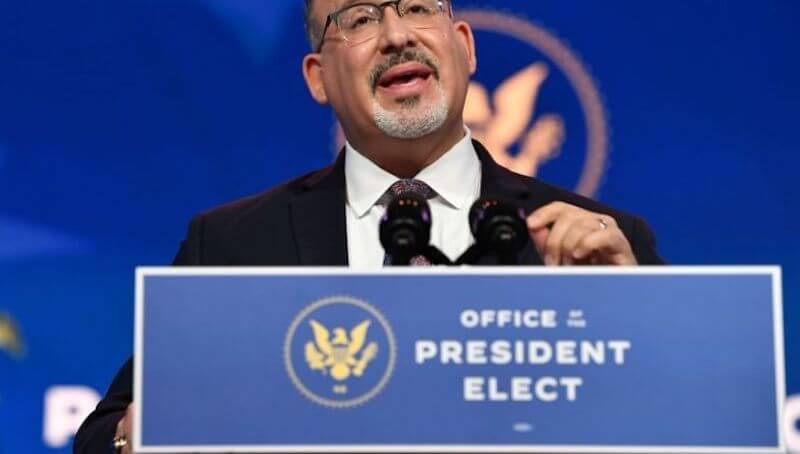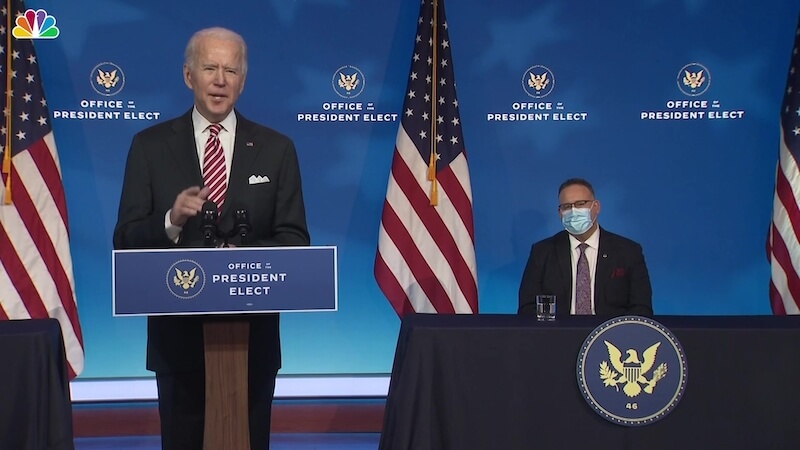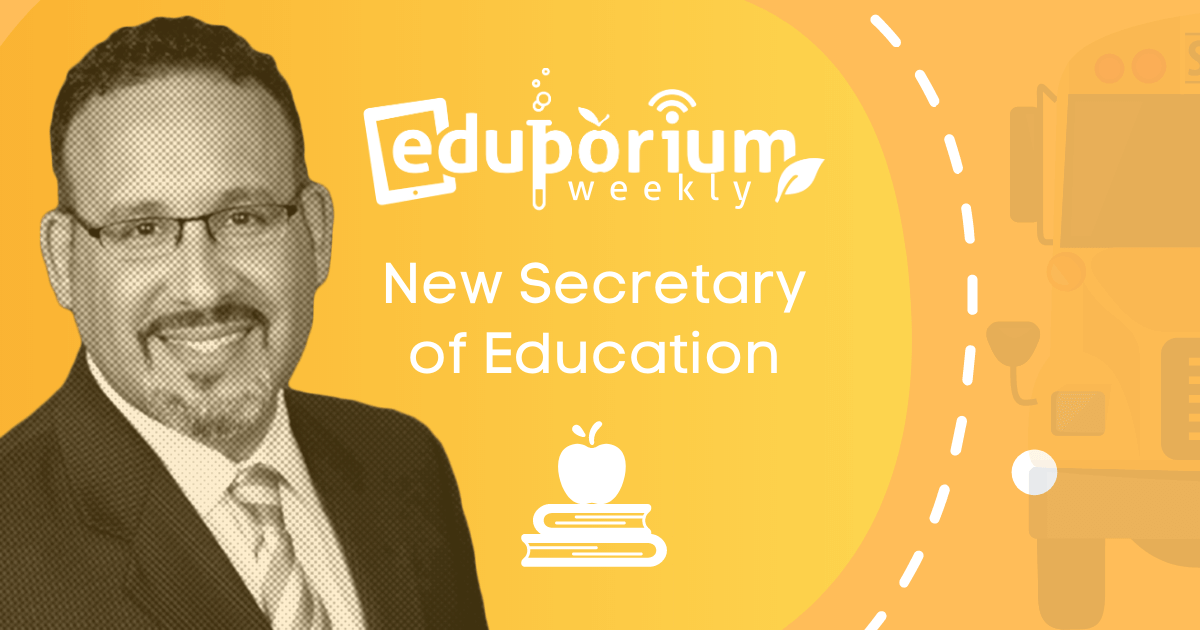As pretty much everybody throughout the education world reacted to and processed the events of the last couple months in particular, there will be a refresh at the top of the country’s institution of education. Next week, a new administration will begin serving, including Miguel Cardona, replacing the previous Education Secretary, Besty DeVos. Before becoming the newest Secretary of Education, Cardona was the Education Chief in Connecticut. He also began his career in education as an elementary teacher before becoming a public school principal as well. So, this week, we’re exploring some key things about Miguel Cardona, the latest Secretary of Education in the United States.
Miguel Cardona’s Background
Cardona and his family have Puerto Rican roots and, as a result, he grew up speaking only Spanish at home. He said he didn’t begin speaking English until attending public schools but his unique perspective has already helped him professionally. It also seems likely it will lend him a unique perspective as he leads the country’s education offerings. Being bilingual, Cardona could provide some valuable perspectives on the struggles that ELLs face. Exacerbated by remote learning and not always having an educator to ask for help, figuring out how to support these students remotely is surely something Cardona will take on. This would certainly help to narrow increasing equity gaps whether in remote learning or otherwise.
Cardona served as Connecticut’s Education Commissioner for just over a year after being appointed to the position in August 2019. He worked in the same district he attended as a student, Meriden Schools in CT, for two decades. He was an elementary teacher and principal before moving on to an administrative role in the central office. There, he led efforts to assess performance and evaluation and, eventually, became the Assistant Superintendent of Teaching and Learning. Cardona was also a part of the Connecticut Legislative Achievement Gap Task Force, serving as a co-chair. With his background in highlighting inequities, it's very possible that Cardona’s early efforts as Education Secretary (besides reopening schools) might address equity gaps in education and providing a more level playing field for the students who are affected.
Cardona was reportedly the first Latino person to serve as Connecticut’s Education Commissioner. He worked to address one of the largest achievement gaps between Hispanic and white students. He also understands the challenges teachers and students in urban areas, in particular, face when trying to access high-quality learning. Of course, serving as Connecticut’s Education Commissioner over the last year has exposed Cardona to planning for school reopenings. After all, that is the biggest immediate task facing him as well as the nation’s students and teachers. He did all he could to get students back into the classroom and used social-emotional connections as a top argument. Of course it will be challenging to fully reopen schools in the near future, but, having overcome a lot already, it seems logical that Cardona will do all he can to make that happen.

Cardona and Reopening Schools
We imagine we’ll learn more specifics about the plans Cardona and present-elect Biden have for safely reopening all of the country’s schools in the coming weeks, but they indicated early on that it would be among their first education priorities. Cardona pushed for reopening schools for in-person instruction last spring and summer while still serving as Connecticut’s Education Commissioner. The hope is that they will be able to make that happen within the administration’s first 100 days. Of course, we know that hoping it will happen and actually following through are two very different prospects, but many schools around the country have been open for all or much of 2020-21. Pinpointing what works in terms of health and safety precautions should certainly help more to reopen. And, then addressing potential learning loss takes over.
Cardona and Biden, as we said, have the goal of reopening the majority of schools within their first 100 days. If you do the math, this would put that process as concluding around the beginning of May, which wouldn’t allow for very much time in the classroom anyway, but it would certainly be quite good for many teachers, students, and parents. One of Cardona’s justifications for returning to classrooms is rebuilding social-emotional connections students need in their academic and personal lives. Since around half of the nation’s K-12 students are currently involved in fully virtual learning, Cardona’s push to get them back in the classroom is not unlike Devos’ except for his willingness to work with teachers and teacher unions to create conditions that are absolutely safe instead of making headway through criticism.
Another big part of reopening schools is the standardized tests that come with almost every school year. Last year, these tests were cancelled but it remains to be seen if they'll happen this this year. Currently, the tests are still required, but so many people have argued in favor of waiving them again. This largely comes down to so many students having not been inside a classroom this year. Cardona has often stated that he believes standardized tests provide education officials with the most accurate picture of where students are in their development and if they are meeting academic expectations. In a time unlike any other, however, it’s reasonable to believe they might perform generally poorer on a standardized test.
Cardona vs. DeVos
It’s nearly certain there will be a sharp shift in the country’s education efforts once Cardona takes over as Secretary. After dealing with reopening schools, many expect Cardona to put a whole lot of time and effort into better understanding and shrinking the achievement gaps that exist in education, specifically between Black and Hispanic students versus white and Asian students. Serving in public education for essentially his entire career should give Cardona advantages over what DeVos brought to the table. The hope is that Cardona will go about his duties with outcomes for students and teachers in the front of his mind instead of using political motives to make decisions and enact policies. Having a very real understanding of how various gaps affect minority students should certainly help enact some positive change.
These days, more than ever, students are benefitting from personalized instruction and experiences instead of blanket lessons and passive projects. This could be an opportunity for Cardona to break away a bit from the status quo and find some creative solutions to allowing this to happen, which would become a lot more challenging if schools are not able to physically reopen. As for reopening schools, it seems that Cardona’s reasons for pushing for this are largely different from DeVos’ arguments. He’s shown impatience with what has happened throughout the pandemic and how its increasing momentum has forced continued remote learning. Rather than making a political statement out of reopening school buildings, hopefully, Cardona and Biden will implement some concrete plans. The top priorities should be safety, social-emotional connections, and a smooth transition back from distance learning.
As for policies, DeVos came into the role with the intention of making school choice a focus area. She stuck to promoting this stance, but didn’t really do a whole lot to advance it during her tenure. She also ran into some pushback when it came to funding for certain school sports that involved transgender students, something that seems unlikely to occur again under the Biden administration, which has presented itself as much more progressive and inclusive. We understand that sometimes difficult decisions are necessary and sometimes the right decisions are unpopular, but we’re looking forward to a fresh start for our country’s students with optimism that those who need help will soon get it in new ways from Secretary Cardona.

Why Biden Chose Cardona
After officials determined the election, President-elect Biden moved pretty quickly to start naming cabinet members and other staffers. Though Cardona was one of the last cabinet members to get his nomination, Biden said it was an easy choice. Why was that? He's referred to Cardona’s background as an educator as one of the top reasons he selected him for this all important role in the administration, implying that these experiences will help in ways that others in the position may not have been able to leverage for one reason or another. Biden was also impressed with how Cardona handled pandemic learning in Connecticut. He ensured every student had devices for remote learning last spring and balanced in-person and remote learning throughout the fall.
Even leading up to the formal nomination of the Education Secretary, Biden said it would be an educator. We’ve certainly touched on Cardona’s career as an educator, which so many around the country are now analyzing. With that background, educators everywhere are hopeful that Cardona can keep his experiences—especially in the past year—in mind from Day 1 and throughout the time he holds the position. While Connecticut’s Education Commissioner, Cardona was also a public school parent, so he knows about remote learning struggles. He even went as far as to say that the pandemic, all of the added stress, and extra time on screens has impacted students in ways that could affect them into the future.
Among his career goals in education, Cardona strives to make learning more equitable for all students, close racial disparities and achievement gaps, and improve classroom experiences for English language learners. Having someone who understands these problems first-hand is important to Biden and perhaps equally important to the newest First Lady. Dr. Jill Biden has spent her career as an educator and plans to continue after moving into the White House. It could be safe to assume that she helps Cardona (we’re not speculating) and could spur positive change. If his words and actions have been an indication, Cardona seems like an Education Secretary who will start fighting for public school students and teachers immediately and that’s certainly a great place to begin.
More to Know About Cardona
Much of the conversation since his nomination has involved Cardona's background as an educator, which is warranted. The past is the past, however, so it’s time to focus more on what he'll accomplish in these four years. Cardona seems poised to want to make an impact at all levels of education—all the way from early childhood to Higher Ed—and for all types of education rather than focusing on the traditional high-school-to-college path. As he advocates for improved public education in K-12 school systems, Cardona also values and advocates for public higher education and making it more accessible for every student who wants to attend. This, coupled with Biden’s notion of free community college, could make higher education different over the next four years.
At his confirmation, Cardona said he believes public education is an equalizer and “a lever for economic success and prosperity.” He also understands the fact that some issues facing K-12 students also plague college students. College students sometimes still come to campus hungry or face issues with securing transportation. And, though these issues are outside the academic umbrella, they're still very much related to education. While in Connecticut, Cardona also did a lot for high school students as they contemplated their next step in education. This included helping to provide community college courses to them while still in high school, offering counseling services to help them gain a better understanding of their goals, and even assisting with financial aid planning.
To that end, it’s possible that Cardona looks to expand the scope of career and technical education programs. When students attend a trade school or earn a certificate, they often set themselves up nicely moving forward. This is another example of his teaching background coming into play as Cardona has likely seen how CTE experiences have helped students thrive and possibly even how a lack thereof wound up hurting others. There certainly is no shortage of agenda items on Cardona’s plate and, after finding a way to safely get millions of students back into the classroom, he’ll hopefully have enough time left to tackle some of his other priorities. He could look to alter student loan repayments, create incentives for loan forgiveness, and more. At the end of the day, hopefully he’ll create more equity and close those ever tricky achievement gaps.
We wish Dr. Cardona the best of luck and look forward to what he can help educators and administrators accomplish! For the latest EdTech, STEM, and 21st century education news, follow Eduporium on Twitter and Instagram. Like us on Facebook, too, or sign up for our newsletter for announcements on the best EdTech deals around! Have an idea for the next Eduporium Weekly theme? Send us a message on any of our social media accounts!



